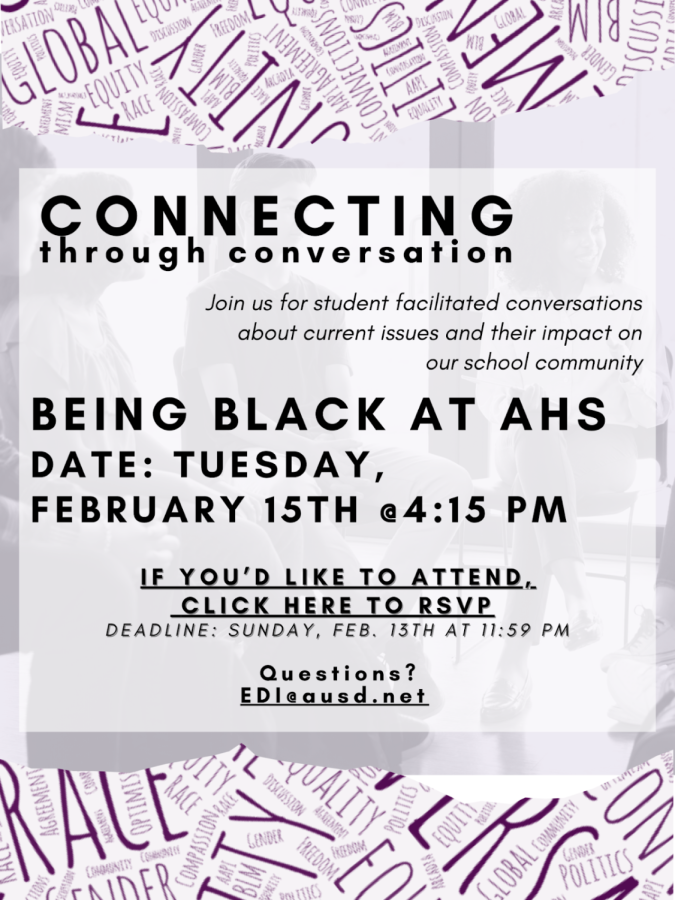Connecting Through Conversation
April 27, 2022
Being Black at Arcadia High School (AHS) is a unique experience. As a campus dominated by an Asian American population, which is often the minority in the greater world, African American students are put in an unusual position as a minority within a minority group. It’s not uncommon to look around the classrooms and throughout the hallways of AHS and see limited numbers of Black students, sometimes not at all. However, AHS Assistant Principal Michele Lew, the AHS Equity, Diversity and Inclusion (EDI) Committee, and the AHS Black Student Union (BSU) have all been working to address some of the issues for African Americans on campus and how to improve their representation.
The lack of Black representation at AHS begins outside of campus. Furthermore, the lack of major representation of cultures outside Asian American culture is also a significant factor that can dissuade non-Asian Americans from being part of the Arcadia community.
On a larger scale, according to a 2019 study by City-Data.com, the median household income of Black families in Arcadia was just over $50,000, less than half of the nearly $109,000 median household income for Asian families. This very much puts the Black community at a disadvantage when looking for real estate in Arcadia, where the average median price of a home, as of January 2022, is a staggering $1.64 million.
For the Black students who are attending AHS, finding a group of people who share the same race or cultural background is often difficult. During a webinar led by the EDI Committee on Feb. 15 titled “Connecting Through Conversations,” the central discussion was the fact that Black students at school may feel isolated due to their limited population on campus. Black students are often the only of their race in their classes, in comparison to the many Asian and white students at school. This extends to both sports and academic teams, where the number of Black students is sparse.
In addition, another major point of the webinar was the unfortunate reality of “joking” but very blatant racism. At AHS, some students use racial slurs, particularly slurs degrading Black people in a casual manner as if it were just another word in the English language. While it is often dismissed by the perpetrator as “a joke” and thus not something meant to be looked too deeply into, this behavior not only is discriminatory towards the specific races which the slurs were originally created to insult, but it also cultivates an uncomfortable environment for all students regardless of their race.
The goal is to provide proper training in discussion of topics surrounding racism and drive class conversations revolving around a difficult subject like race. While having such discussions in the classroom could prove to be beneficial, it can sometimes prove challenging to find a balance between addressing topics surrounding racism appropriately and keeping the discussion objective as possible.
As English teacher Mrs. Paola Bisharat brought up, some individuals are not as accustomed to discussing racism in comparison to others.
“I believe that some individuals (regardless of generation) feel uncomfortable discussing such issues, and that is understandable. The goal is to provide teachers with tools as to how to navigate these controversial topics/conversations while providing an inclusive environment where students feel safe expressing their viewpoints.”
The final topic discussed during the webinar was that although AHS hasn’t made any direct actions to hold back Black students or make them feel unwelcome, the school could be doing far more to make Black students more represented. The BSU serves as one of the few standout representatives of Black students on campus and is open to students of all races. However, according to sophomore Isaiah McMahon, who is one of the leaders of the BSU, some Black students may feel they need to fit under a certain category, such as an athlete or a nerd, in order to be a part of the BSU, when that’s not necessary.
“You don’t have to feel like you have to be a nerd or something to be in the BSU. It’s not necessarily an academic thing; it’s just a union, unity for Black people. I think the school can do a better job of promoting the BSU,” he stated.
In comparison, other clubs with much larger student bases and more involvement on campus have a much higher chance of gaining new members due to the already existing reputations they have. This leaves not only the BSU, but other smaller clubs on campus at a disadvantage in not only keeping the club open, but also securing a future for the club in upcoming school years. However, while Black students deserve more representation at school, such representation shouldn’t be forced.
The representation of Black students at AHS has become a rising discussion. Through cooperation between students, teachers, and other members of the AHS and greater Arcadia community, regardless of their race, the uniqueness of African American culture and people can be better brought to light in order to teach the student base what it means to be Black at school and how that can be like.
Photo courtesy of ARCADIA EDI COMMITTEE

